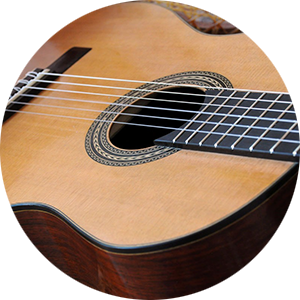
Latin-American & Brazilian Guitar

Guitar Lessons
The Global Music School offers guitar lessons for acoustic guitar, electric guitar, flamenco guitar and Latin-American & Brazilian Guitar.
Latin-American Guitar
From Mexico to Argentina. The guitar is one of the most versatile instruments in the world. And since his arrival in America it has taken many forms and peculiarities. It is impossible to speak of one way of playing Latin guitar, but there are some points of connection that we are going to see in the course. Everything will be focused on the role that the guitar plays in each music style.
The course will be taught on the nylon acoustic guitar, but any electric guitar, ukulele or string instrument is welcome.
The course is 80% practical and 20% theoretical.
Key Rhythms: Cuban Son, Bolero, Bossa nova, Tango, Cumbia, Danzón, Peruvian Waltz, Samba among others.
Brazilian Guitar
The guitar is the main instrument of the popular Brazilian composers. It is therefore one of the keys to understand the Brazilian music Universe. In the lessons we will explain its function within the different musical styles. We will learn varied repertoire from different parts of Brazil with focus on the “levadas“ (Portuguese for guitar rhythms). We will analyze for example the way of playing of great Brazilian guitarists such as João Gilberto, Baden Powell, among others.
The Lessons are planned for all levels.
In the Beginning/intermediate guitar class we will focus on basic chords progressions and rhythms found in Brazilian popular music. The different concepts will be applied in learning songs from the great Brazilian composers.
In the advanced guitar class, we will explore the universe of Brazilian music, including its influences, styles and trends, applying it to composition, comping and improvisation.
Learn more about the instrument
The sounds of the acoustic guitar is caused by plucking or hitting the strings and amplified by the body of the guitar. Of particular importance for the sound are, inter alia, the quality of the wood. The acoustic guitar usually has six strings and is usually covered with nylon strings. It has a warm sound and is very suitable for Flamenco, Jazz, Brazilian music and Pop. The first concert guitars of today’s size and design can be found in Spain from the middle of the 19th century. One of the most important luthiers was Antonio de Torres. He enlarged the baroque guitar and achieved an instrument with greater assertiveness, more dynamics and a more intense sound color. The name guitar derives on the one hand from the Persian “Târ”, a 4000-year-old long-necked lute and on the other hand from the Greek Kithara.
Teacher
Adrián Flores Ibáñez
More Info:
Jazz/Latin Guitar: Adrián Flores Ibáñez
Languages
Spanish, English, German
Related courses
Acoustic Guitar
Electric Guitar
Flamenco Guitar


